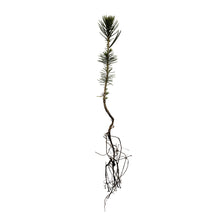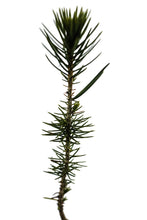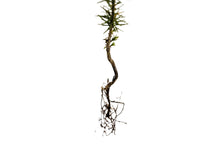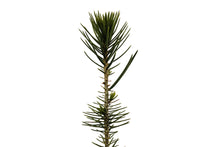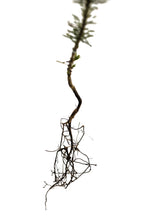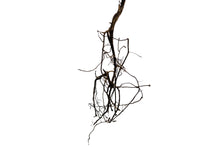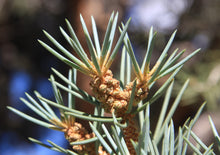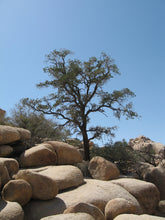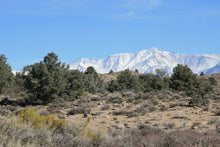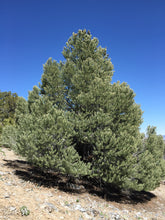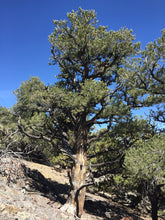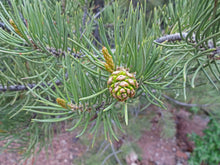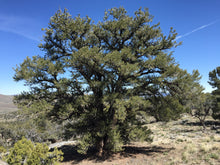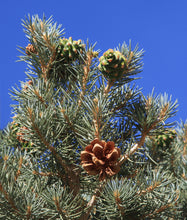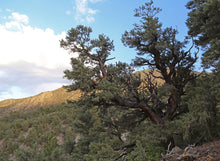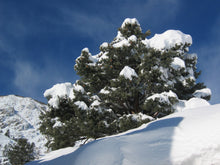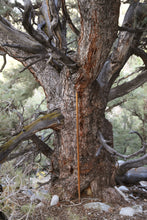
Pinus monophylla
-
Grow your own Piñon Pine, the only one-needled pine tree in the world
- 100% guaranteed
- Seed-grown on California's Redwood Coast
- Transplanting and care instructions included
Nursery Note: Please be aware that these trees are sent bare root (without soil around their roots), and should be potted up right away. Happy planting!
 |
Moisture Low |
 |
Cold Hardiness -15°F |
 |
Light Full Sun |
 |
Size 20 – 40' tall / 10 – 20' spread |
 |
Lifespan 1,000 yrs |
 |
Growth Rate Slow Growing |
 |
Drought Tolerance High |
 |
Wind Resistance High |
About Piñon Pine
From the U.S. Forest Service:
"Mature singleleaf pinyon is typically a short tree (20-40 feet (6-12 m) tall), with a rounded to flat-topped crown and multiple, upswept branches due to lack of self-pruning. It may occasionally be multi-stemmed from simultaneous establishment from seed caches. It generally forms open woodlands. Bark is smooth and thin (0.4-0.8 inch (1-2 cm)) on young trees, forming deep, irregular fissures and ridges with thin scales, and is up to an inch thick with age. The wood is light and soft, not strong or resinous. Singleleaf pinyon has an extensive lateral root system, giving it the ability to penetrate into open areas between tree canopies and extract water and nutrients. Its ability to invade adjacent shrublands may also be related to the tree's ability to maintain a seasonally stable xylem water potential and thereby to endure drought better than the associated shrubs.
The needles of singleleaf pinyon are solitary, rigid, and 1 to 1.4 inches (2.5-3.5 cm) long. The sheaths deciduous. The single needle (leaf) is unique among pines of the world. Singleleaf pinyon needles are long-lived (5-12 years). Their longevity is considered an extreme expression of "evergreenness," giving the tree the ability to conserve nutrients to take advantage of short favorable conditions within a generally unfavorable period. The allelopathic effects of singleleaf pinyon needle litter on germination and growth of herbaceous plants has been documented, and is attributed to terpene hydrocarbons. These compounds also impede decomposition, are highly flammable, and are readily volatilized by fire.
Singleleaf pinyon bears ovulate cones, 1.4 to 2.2 inches (3.5-5.5 cm) long, with thick scales. Cones bear large (0.4-0.7 inch (10-17 mm) long), heavy (0.01 oz (400 mg)), moderately thin-shelled, edible, wingless seeds. Cones that dry and open in the fall drop to the ground in winter or spring and may form a conspicuous litter layer.
Singleleaf pinyon is long-lived. On fire-safe sites, large trees can monopolize site resources over a life span of 350 years or more. Dominant pinyons are often 400 years old and have been known to reach 800 to 1000 years. Mature singleleaf pinyon trees (over 200 years) are relatively uncommon. Of the 20 million acres of pinyon-juniper stands in Nevada and Utah, about half are estimated to be between 40 and 120 years old, with almost 20% in Utah and 9% in Nevada over 200 years of age. Biomass estimates for singleleaf pinyon are available for Nevada.
Hybrids are diagnosed by frequency of monophylly and leaf resin canal number. Hybrids of singleleaf and Colorado pinyon have a mixture of 1- and 2-needle fascicles on the same branchlets, fewer resin ducts than singleleaf pinyon but more than Colorado pinyon, and intermediate cone size.
Singleleaf pinyon is adapted to a wide variety of sites. It usually grows on pediments, dry, rocky slopes, ridges, and alluvial fans and is rarely found on valley floors. It is frost resistant, tolerant of drought, and requires full sunlight for maximum growth. On favorable sites where past mismanagement has not been severe, the woodland may form a dense cover with trees 30 to 40 feet (9-12 m) tall. On drier sites spacing widens and tree size diminishes. Old-growth or climax stands of singleleaf pinyon often occupy rocky hillslopes where the sparse understory will not carry fire. At the northern end of its range, singleleaf pinyon is found primarily on south-facing slopes and outcrops of decomposed granite. At the southern end of its range it occurs only on north-facing slopes."
About Jonsteen's Seedlings
All of our trees are seed-grown at our nursery on California's Redwood Coast, which is inspected monthly and licensed by the California Department of Agriculture. Trees can provide a natural barrier against high winds, temperatures, noise pollution and soil erosion, all while benefiting local air quality, wildlife and property values — a Jonsteen seedling will only grow in value and beauty!
About Jonsteen's 100% Guarantee
All of our trees are guaranteed to arrive healthy and in good condition. If your tree perishes despite your honest efforts, we will be happy to replace it with a small-sized seedling for just the cost of shipping/handling. You can learn more about our guarantee and tree replacement policy here.
Seedling Size Chart: Small
Due to the dynamic nature of actively growing trees, as well as the tremendous variation between species’ growth rates, we rely on the cubic volume of a seedling’s root mass to determine its “size” (Small / Medium / Large / XL). Within each size there is minor variance — the dimensions provided here represent the category minimum. If exact measurements are essential, please contact us about current stock.




















